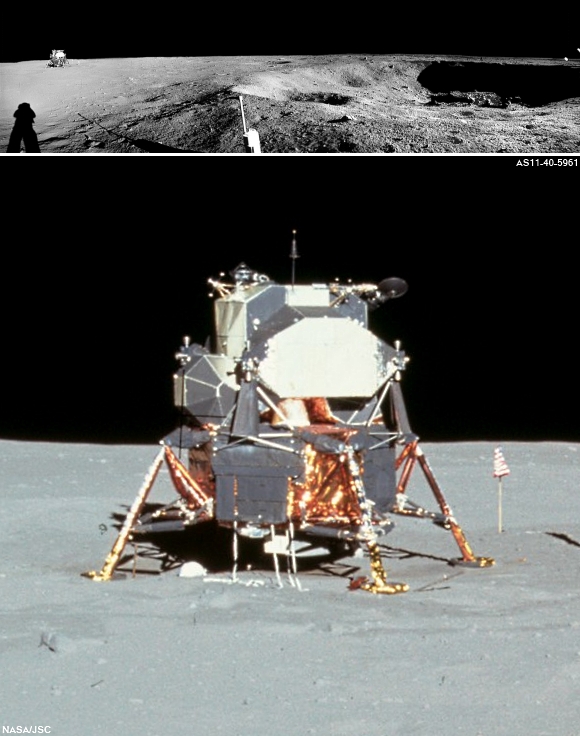 |
| A Stark Beauty All Its Own, Apollo 11 from low altitude (~25km altitude), LROC's best look yet at the July 20, 1969 landing site (0.672°N, 23.483°E) in the southwestern corner of Mare Tranquillitatis - Remnants of Armstrong & Aldrin's historic first steps on the surface are clearly visible in darker paths around the Lunar Module Eagle Descent Stage, Lunar Ranging RetroReflector (LRRR) and Passive Seismic Experiment Package (PSEP) and Aldrin's short path behind the lander to the rim of Little West crater. LROC Narrow Angle Camera (NAC) observation M175124932R, LRO orbit 10,942, November 5, 2011; resolution 25 centimeters per pixel. View the wider field of view in the LROC Featured Image HERE [NASA/GSFC/Arizona State University]. |
Principal Investigator
Lunar Reconnaissance Orbiter Camera (LROC)
Arizona State University
This image of the Apollo 11 landing site captured from just 24 km (15 miles) above the surface provides LRO's best look yet at humanity’s first venture to another world. When Neil Armstrong took his famous first steps onto the lunar surface, he kicked around the soil. “Yes, the surface is fine and powdery.” Gazing at the flat horizon, he took in the view. “Isn’t that something! Magnificent sight out here.” After collecting a contingency sample Neil looked around and observed, "it has a stark beauty all its own. It's like much of the high desert of the United States. It's different, but it's very pretty out here." A few minutes later Buzz Aldrin descended the ladder and joined Neil on the surface of the Moon!
You can see the remnants of their first steps as dark regions around the Lunar Module (LM) and in dark tracks that lead to the scientific experiments the astronauts set up on the surface. The Passive Seismic Experiment Package (PSEP) provided the first lunar seismic data, returning data for three weeks after the astronauts left, and the Laser Ranging RetroReflector (LRRR) allows precise measurements to be collected to this day. You can even spot the discarded cover of the LRRR.
 |
| Aldrin deploys the solar array of the Passive Seismic Experiment Package (PSEP) at Mission Elapsed Time (MET) 111 hours, 6 minutes and 40 seconds, July 20, 1969. Behind him are other items noted in the LROC orbital close-up imaged 42 years later, including the lunar ranging retro-reflector (LRRR), Discarded Cover and television camera (AS11-40-5947) [Neil Armstrong/NASA JSC/ ALSJ]. |
Another trail leads toward Little West crater around 50 meters (164
feet) to the east of the LM. This was an unplanned excursion near the
end of the two and a half hours spent on the surface. Armstrong ran over
to get a look inside the crater, and this was the farthest either
astronaut ventured from the landing site. Compared to Apollo 12 and 14,
which allowed for more time on the surface, and Apollo 15, 16, and 17,
which had the benefit of a Lunar Roving Vehicle, Armstrong and Aldrin's
surface activities were quite restricted. Their tracks cover less area
than a typical city block!
 |
| Full resolution detail from AS11-40-5961, part of a lunar surface "early-morning" down-sun panorama stitched from a series of photographs taken from the rim of Little West crater (MET 111:11:31). A very short Moon walk, the The entire area covered by Armstrong & Aldrin would fit in a standard basketball court [Neil Armstrong/NASA/ALSJ]. |
Not only was the landscape a place of "stark beauty", but also the source of rocks that revealed the Moon’s fiery past for the first time. The samples showed that the Apollo 11 landing site in Mare Tranquillitatis was once the site of volcanic activity, and the flat surface that afforded such an incredible vista was due to broad, thin flows of lava that flooded the region.
Check out past views of the Apollo 11 site at lower resolution (but complementary illumination angles):
Browse the full resolution NAC image HERE.


No comments:
Post a Comment